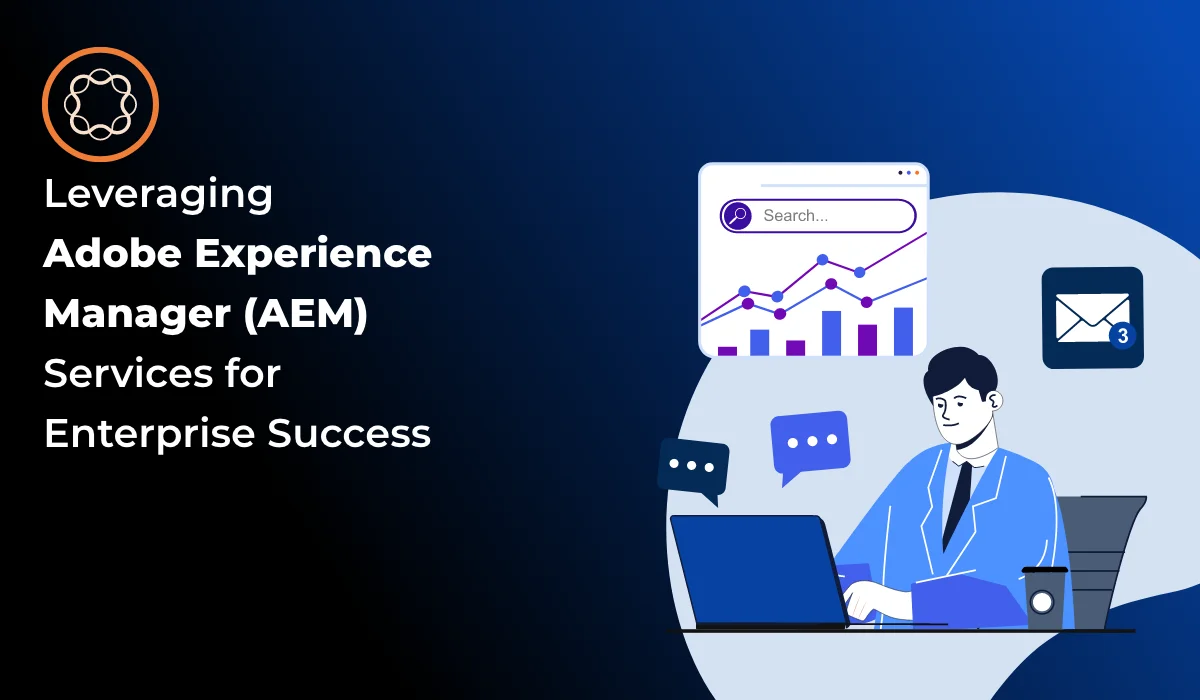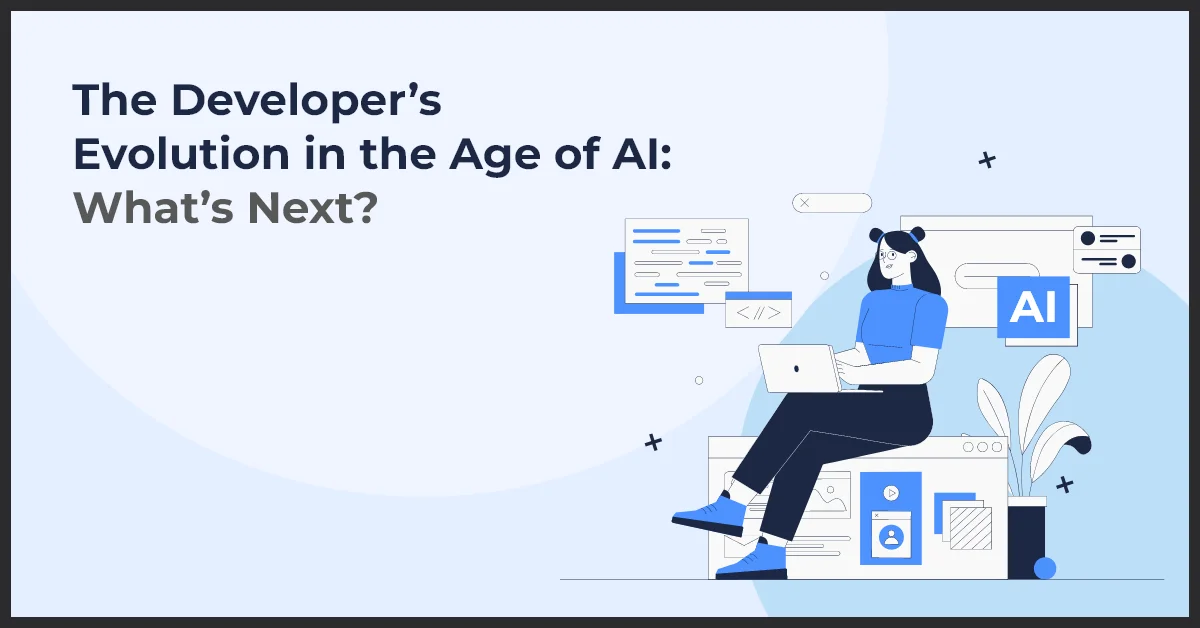Leveraging Adobe Experience Manager (AEM) Services for Enterprise Success

Published on: June 3, 2022
Updated on: October 07, 2024
2976 Views
- Development
11 min read
Marketers are early adopters of technology, with studies claiming that an average enterprise uses at least 120 Martech solutions. Despite that, marketers still find it challenging to produce an omnichannel and personalized user experience. The reason? These tools work in silos.
Adobe Experience Manager (AEM) overcomes this challenge by efficiently delivering personalized digital experiences to worldwide customers on multiple channels. It eventually increases revenue since omnichannel shoppers spend 4% more on purchasing online than customers who complete their buyer’s journey via a single platform.
What Is Adobe Experience Manager?
AEM is a robust and reliable web content management system (CMS) ideal for creating and driving high-traffic websites, digital assets, and mobile applications. Adobe CMS allows organizations to effectively mobilize their digital assets and consistently deliver high-quality user experiences across all digital touchpoints. As a result, businesses can realize a vibrant online presence, driving profitable and lasting customer relationships.
How Does Adobe Experience Manager Work?
AEM is based on Apache Sling which is a Java-based application. It uses JCR (Java Content Repository), an object database for storing information. Apache Sling comes with its HTTP server, which functions as a Web Application when aligned with Jetty, an Application server. These allow content marketers to create and deliver immersive digital experiences for end users.
The design architecture of Adobe Experience Manager makes it easily integrable with Adobe Marketing Cloud product suite. It is interoperable with tools like Adobe Analytics, Adobe Commerce Cloud, Marketo Engage, Adobe Target, and Adobe Audience Manager. Together with other advanced digital marketing tools, it lets users gain insights into the visitors across touchpoints right through their buying journey.
Adobe Experience Manager lets marketers handle many tasks, including tracking conversion rate optimization, personalizing content, identifying ads with higher engagement rates, and improving sales prospects. It goes beyond the purview of typical marketing tools and lets organizations manage customer relationships. Using it, organizations can deliver personalized experiences across different channels and leverage Adobe's tailored marketing solutions.
The tool increases the marketing team's control over customer segmentation, lifecycle marketing, data analytics, and more. Designers can use it for user-friendly front-end applications, while developers also find it helpful in creating, accessing, and reusing content elements for frictionless user experience across different projects.
Top Benefits of Adobe Experience Manager
Adobe Experience Manager is a flexible CMS solution that you can implement across web pages, digital assets, forms & communities, and mobile. Being a high-end digital platform, AEM simplifies the process of designing, developing, managing, and optimizing any number of websites and mobile applications in multiple languages. In addition, it:
- Is flexible and scalable: You can easily publish content across multiple channels and send it to millions of users in dozens of languages.
- Is a best-in-class tool: It is ranked as a leading CMS solution and easily integrates with Adobe Experience Cloud. AEM provides multiple options including
- Multi-site manager (MSM), which lets users define a relation between websites so that changes made on one website are reflected on the other.
- The open-source web content management (WCM), which blends functionalities of CMS and marketing channels into a unified platform.
- Digital asset management (DAM), which lets you search, edit, manage and deliver digital content assets in a single platform.
- Is easy to use: Be more productive with easy-to-use features such as inline editing and drag-and-drop interface.
- Enables personalized experiences: Create an unmatched marketing machine for delivering personalized and customized experiences by integrating with Adobe Target and Adobe Analytics.
- Allows to target customers where they prefer: As your shoppers’ needs constantly change, meet them on the channel they like to use. Use AEM to update your content from one channel to another to align with your users’ changing requirements and interests.
- Powers you to achieve better speed to market: Eliminate workflow complexity and simplify content creation, management, and distribution. Connect Adobe’s Creative Cloud with AEM to move new marketing assets into existing campaigns.
- Boosts collaboration: Allow your teammates to access data related to campaigns, marketing assets, pages, templates, and projects.
Who Can Benefit from AEM?
Pretty much everyone. From retail, financial services, and ecommerce to manufacturing and media and entertainment, AEM can be used by businesses across industries to centralize data and scale customization. It is a popular solution since it has easier workflows that can be used even by non-technical marketers.
Key Features of Adobe Experience Manager
In the huge list of what AEM has to offer, the key features have strong odds to get lost. Let’s go through them here to make it easier for you:
1. Content Management System
Content is the backbone of marketing. As your organization grows, so does the content. It creates a need to provide optimized search results, personalized information, and relevant offers to each customer.
AEM easily allows you to manage your brand assets and online content across multiple devices and channels. With AEM, you can use pre-built templates to create responsive websites quickly.
2. Cloud Service
AEM has a cloud-native CMS that allows you to manage your website safely without any costly upgrades. AEM Cloud service is a great way to build sites that your users will love.
You can also leverage AEM as a cloud service. It uses the power of cloud technologies to develop and host AEM solutions. Cloud power and new microservice architecture allow it to auto-scale as per the need to serve increased or decreased load spikes, thereby eliminating the need to worry about right-sizing your infrastructure.
3. Digital Asset Management
Provide immersive content experience to audiences across channels with AEM’s digital asset management, which has automated workflows that takes content from multiple sources. Its Management Console centralizes assets so that you can search and share marketing collaterals with the right people at the right time.
4. Digital Forms
AEM Forms allow you to capture critical user information to personalize end-to-end onboarding and enrolment journeys. It includes easy-to-use responsive forms and other intuitive features for a streamlined enrollment process.
5. Dashboards
AEM also includes project dashboards that provide an overview of your current campaigns. Use the dashboard to get key insights into project status and know the status of defined goals and business outcomes. It also gives access to other related assets, including connections and team members.
Adobe Experience Manager Developer Role
Developers have a vital role and can shape an organization's digital footprint using Adobe Experience Manager. Their role decides the marketing campaign's commercial success and overall customer satisfaction. Here are some of the skills that developers must have to create the right digital experience
1. Front-end Development
Developers use AEM for front-end development. Comprehensive knowledge of front-end code is a must for every developer. Expertise in task runners such as NPM, Node, and Gulp/Grunt is a must-have skill for developers.
2. Front-end Development
Developers use AEM for front-end development. Comprehensive knowledge of front-end code is a must for every developer. Expertise in task runners such as NPM, Node, and Gulp/Grunt is a must-have skill for developers.
3. UX Design
Strong knowledge of UX design is important for an AEM developer. It helps them develop deep insights into what engages the user and improves their experience when interacting with digital platforms.
4. AEM Component Development
AEM Components are vital for the end user experience, and hence the developer must have in-depth knowledge of creating XML dialogs and client libraries.
5. AEM OSGi and Servlets Development
A strong background in OSGi frameworks, OSGi services, and OSGi annotations is a must for every AEM developer to develop OSGi and Servlets.
What Should You Look for in an AEM Service Provider?
If you are looking to partner with an agency to create a solution on AEM, maintain AEM web properties, and augment your team with AEM experts, then you must make sure your partner agency provides a complete AEM package:
1. Consulting and Implementation
Opt for AEM implementation service (Adobe CQ5 installation) to get in-depth consultation and implementation that lets you offer your website visitors a seamless digital experience.
2. Custom AEM Design
It helps you create mock-ups aligned with your business objectives. For everything from AEM solution design to implementation, your agency should consider your feedback, changes, and approvals.
3. Intuitive Content Experience
Adobe's Touch User Interface feature is intuitive and offers seamless authoring experiences across multiple devices. With content authors, you can easily create content fragments and distribute them across various channels to ensure consistent user experiences.
4. CMS Migration & Integration
Want to migrate to the AEM system? No problem! Having experts can help you shift from Sitecore, SharePoint, Drupal, Joomla, Alfresco, Vignette, and custom CMS to Adobe CMS without losing data and value. They also help undertake custom integration of Adobe CMS with a range of third-party platforms and popular software such as Salesforce, SAP, and Microsoft.
5. AEM Maintenance and Support
Ensure comprehensive maintenance and support services for all AEM integration and implementation. When you take advantage of technical support, device monitoring, and maintenance expertise, it helps you create interactive omnichannel customer experiences.
6. AEM-Adobe Marketing Cloud Integration
Make the most out of the Adobe suite of solutions by integrating AEM with other Adobe modules, including Social, Site Catalyst, Audience Manager, Test & Target, and Scene7.
7. SEO and User Experience
Search Engine Optimization (SEO) is one of the main concerns for many marketers. And these concerns need to be addressed on various AEM projects.
AEM scans content and automatically assigns tags and metadata to all your online content assets. Partnering with SEO experts helps optimize it further for the best web vitals and improved site rank.
How Is AEM Better Than Other Content Management System Solutions?
Adobe Experience Manager enjoys considerable advantages over stock content management systems and can take your marketing campaign to the next level. Here's why marketers chose it over other content management system solutions.
- Easier integration - It is easily integrable with other marketing tools. Marketers use dozens of tools, and one can seamlessly integrate AEM with them. AEM connectors let developers integrate it with third-party tools.
- Automation – AEM allows automation of metadata and content tag designation. Big enterprises publish a large quantity of content which must be optimized with metadata and tags to boost the SEO score. Doing this manually is time-consuming, and AEM automates this process by designating suitable metadata and tags.
- In-Built Content Modules – AEM comes with pre-installed content modules such as website layouts, forms, workflows, etc. Using these, developers can deploy code faster, improving turnaround time and reducing development costs.
- Centralize Database – Organizations operating across geographies must manage multilingual websites and content. AEM lets teams in different corners of the world store multi-channel content and manage different assets from one centralized location. It improves collaboration and improves productivity.
- Developer-Driven Customization - AEM supports developer-driven customization, allowing large enterprises to develop customized components for their digital assets.
- Workflow Management – In large enterprises, different teams are tasked with website content management. AEM CMS workflows help distribute tasks between different teams and individuals.
- Security – Security is non-negotiable, and AEM lets organizations create secure and reliable digital assets protecting the privacy of their end users.
- Scalability – It is a highly scalable tool. It can accommodate the needs of an organization when it grows and targets users across different devices and platforms, making it a go-to look for organizations with a global footprint.
Want to Optimize Digital Experiences With AEM? Get in Touch.
Marketing is more than just a website experience. It includes creating different campaigns, tracking data, and reaching your target audience with the right message at the right time. Adobe Experience Manager is a step ahead in providing a wholesome solution above and beyond simple website management.
Growth Natives, as a solution provider, boasts of a line-up of Adobe professionals who utilize their proven skills to deliver the best AEM solutions. If you are at the crossroads of growth and objectives, choose us as your extended team and we will help you design, execute, and deliver highly personalized omnichannel digital experiences. Get in touch with us at info@growthnatives.com to know more.
Frequently Asked Questions
Adobe managed services offer several benefits, including:
- Improved performance and reliability: Adobe’s managed services ensure that your Adobe applications and services are always up-to-date and running smoothly.
- Enhanced security: Adobe’s managed services include robust security measures to protect your data and applications from cyber threats.
- Scalability: Adobe’s managed services are designed to scale with your business, allowing you to easily expand your use of Adobe products as your business grows.
- Cost-effectiveness: Adobe’s managed services can help reduce IT costs by eliminating the need for dedicated IT staff to manage Adobe applications and services.
Adobe Experience Platform is a comprehensive platform that allows businesses to create, manage, and deliver personalized experiences across all channels and touchpoints. When used in conjunction with AEM as a cloud service, Adobe Experience Platform enhances the capabilities of AEM by providing advanced data management and analytics features, enabling businesses to gain deeper insights into customer behavior and preferences and deliver more personalized experiences.
Adobe Experience Manager is used by a wide range of companies across industries, including retail, financial services, healthcare, and media and entertainment. Some notable companies that use Adobe Experience Manager include Coca-Cola, Audi, and MGM Resorts.



